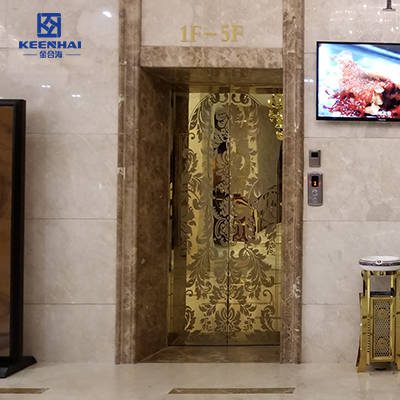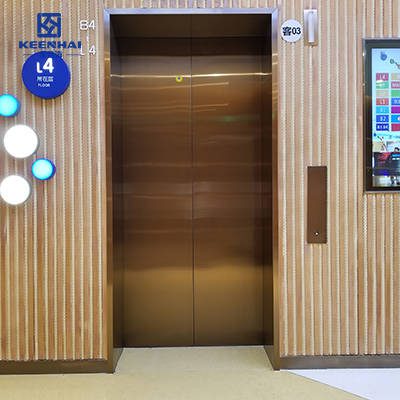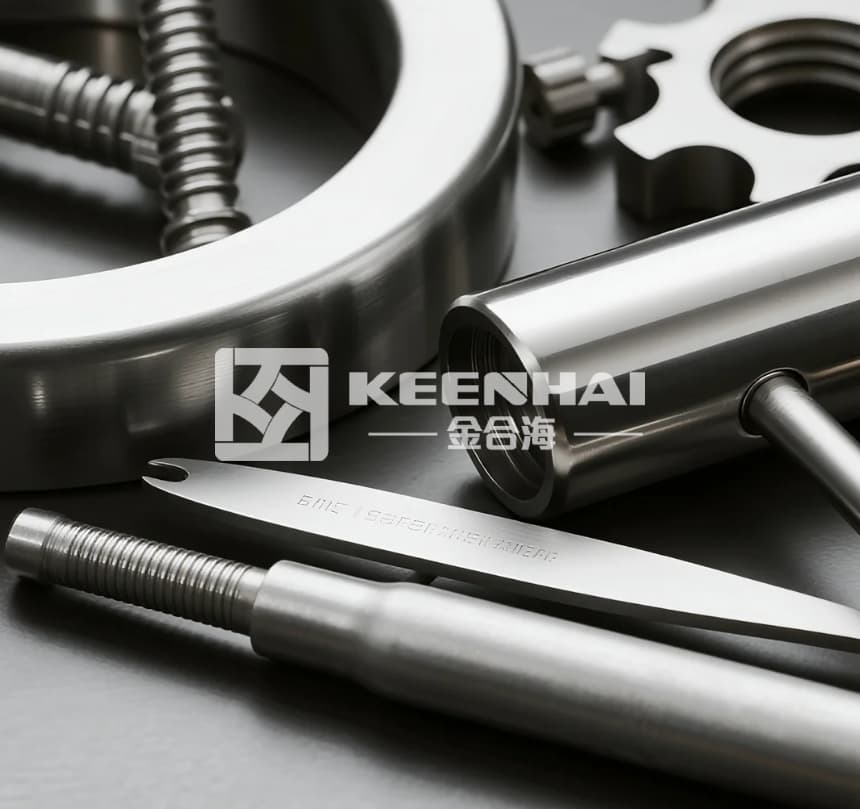Instead of relying on paints or plating that can wear off, PVD coated stainless steel uses a vacuum-based process to bond color and protection directly onto the steel surface. This makes the finish highly resistant to fading, corrosion, and fingerprints. In real life, it means an elevator door, handrail, or wall panel can keep its original look even after years of heavy use. Many developers choose PVD because it reduces maintenance costs while adding a high-end feel to public or residential spaces. It’s both practical and stylish.
Understanding PVD Technology
1.1 Definition of PVD (Physical Vapor Deposition)
Physical Vapor Deposition, abbreviated as PVD, refers to a high-vacuum coating technique where solid materials are vaporized and condensed onto a substrate. In the context of stainless steel, this process creates an extremely thin but durable layer, usually between 0.2 and 5 microns thick. Unlike traditional painting or electroplating, PVD bonds materials at the atomic level, which significantly improves hardness and longevity.
Market data illustrates the rapid adoption of PVD in surface finishing. A 2023 report from MarketsandMarkets estimated that the global PVD market size surpassed USD 25 billion, with stainless steel applications accounting for more than 35% of the demand. This widespread use demonstrates how industries prioritize PVD for both decorative and functional purposes, especially in areas where durability and aesthetic appeal are essential.
1.2 How the Coating Process Works
The PVD process operates in a controlled vacuum environment, and the sequence typically follows these steps:
-
Surface Cleaning – The stainless steel surface is mechanically polished and chemically cleaned to remove oxides, oil, or contaminants. Without proper cleaning, adhesion cannot occur.
-
Vacuum Chamber Preparation – The cleaned component is placed inside a chamber where pressure drops to below 1×10⁻³ Pa, eliminating air molecules that could interfere with deposition.
-
Material Vaporization – A solid coating material such as titanium, zirconium, or chromium is heated by arc evaporation or magnetron sputtering until it vaporizes.
-
Atomic-Level Bonding – The vaporized atoms collide with the stainless steel surface, forming a dense, uniform layer that integrates with the base metal.
-
Cooling and Quality Check – After deposition, the coated part is cooled, then tested for thickness, hardness, and adhesion.
This workflow allows for extremely precise coatings. According to a 2022 study published in Surface and Coatings Technology, PVD coatings can achieve hardness levels above 2000 HV on the Vickers scale, nearly four times that of untreated stainless steel.
1.3 Materials Commonly Used in PVD Coatings
PVD technology enables a wide range of metallic compounds to be applied, each with distinct physical and visual benefits.
-
Titanium Nitride (TiN): Recognized for its gold-like finish and hardness exceeding 2200 HV, it is often used in high-end decorative stainless steel.
-
Zirconium Nitride (ZrN): Provides warm bronze tones and excellent wear resistance, making it suitable for decorative panels in public buildings.
-
Chromium Nitride (CrN): Offers high corrosion resistance and a silver metallic look, commonly applied in functional surfaces.
-
Titanium Carbonitride (TiCN): Produces a grey-blue hue with enhanced toughness, ideal for applications requiring both aesthetics and strength.
In architectural design, CrN and ZrN are favored for their ability to withstand outdoor conditions without fading. This is why many premium ষ্টেইনলেছ ষ্টীলৰ লিফ্টৰ দুৱাৰ are treated with PVD coatings, combining performance with modern aesthetics (see stainless steel elevator doors).

Characteristics of PVD Coated Stainless Steel
2.1 Surface Hardness and Scratch Resistance
One of the biggest advantages of PVD-coated stainless steel is the dramatic increase in surface hardness. Standard stainless steel typically measures between 150 and 200 HV on the Vickers hardness scale. When treated with a PVD layer, hardness can easily reach 1200–2500 HV, depending on the coating material used. This improvement means the surface resists scratches from daily wear, whether from keys, rings, or cleaning equipment.
A 2022 durability test carried out by the International Journal of Materials Research compared untreated stainless steel to PVD-coated samples. After 5,000 abrasion cycles, untreated panels showed visible scratches covering over 70% of the test surface, while PVD-coated samples maintained a smooth finish with only 5–10% superficial marks. These results are why the technology has become popular in high-contact areas such as elevator doors in commercial buildings, where both durability and appearance matter.
2.2 Color Variations and Aesthetic Appeal
Beyond toughness, PVD also unlocks a wide range of color choices that natural stainless steel cannot achieve. Instead of relying on paints or chemical coatings, the colors come from metallic compounds deposited atom by atom, which creates tones that are vibrant yet permanent.
For instance, Titanium Nitride produces a deep gold finish, while Zirconium Nitride offers warm champagne and bronze tones. Chromium-based coatings bring out cooler shades like silver and graphite. Designers often combine multiple coatings to achieve gradient effects or mirror-polished finishes that remain stable under UV light.
A survey by Architectural Products Magazine in 2023 found that over 65% of architects preferred PVD-coated stainless steel panels when designing modern lobbies and transport hubs. Their main reasons included long-term color stability and the premium look compared to painted metals. It is common to see this technology applied to stainless steel elevator entrance systems in high-traffic buildings, giving the structure a contemporary yet practical aesthetic (explore stainless steel elevator entrances).
2.3 Corrosion and Oxidation Resistance
Another defining characteristic is corrosion resistance. Standard stainless steel already contains chromium that forms a passive oxide layer, but PVD adds an extra protective shield. This layer prevents direct exposure of the steel to moisture, salt, or chemicals, which significantly slows down corrosion.
In a salt spray test performed by ASTM International, PVD-coated stainless steel lasted more than 1,500 hours without visible corrosion, compared to about 200–300 hours for untreated stainless steel of the same grade. The additional layer also minimizes oxidation at high temperatures, making it suitable for both indoor and outdoor installations.
This level of protection is particularly valuable for stainless steel residential elevator doors, where homeowners want long-lasting finishes that don’t tarnish even in coastal or humid environments (see residential elevator doors). By combining beauty with resilience, PVD-coated stainless steel helps reduce maintenance costs while ensuring the material keeps its high-end look for decades.

PVD Coating Process on Stainless Steel
3.1 Surface Preparation of Stainless Steel
The first step in the PVD coating process always comes down to preparation. Stainless steel, no matter how smooth it looks to the eye, carries microscopic imperfections, oil residues, or even fingerprints that can ruin the final finish if not handled correctly. To avoid these problems, the material goes through a series of cleaning stages.
-
Degreasing and ultrasonic cleaning – The sheets or fabricated parts are washed in a chemical solution to remove grease, dust, or polishing paste. Ultrasonic cleaning is often used because the vibration can reach corners that normal cleaning cannot.
-
Drying under controlled temperature – After cleaning, the surface is dried in a dust-free environment to prevent new particles from sticking.
-
Mechanical or chemical polishing – If the steel is going to be used for a high-end project, like the lobby walls of a five-star hotel, extra polishing ensures the surface is mirror-like before the coating starts.
A real-world example comes from PVD stainless steel cladding in modern architecture, where developers in Dubai used brushed stainless panels for a luxury shopping mall entrance. Without this step-by-step preparation, the gold-colored finish would have shown dull patches or streaks, which is unacceptable in such high-visibility projects.
3.2 Deposition Stages in the Vacuum Chamber
Once the steel is prepared, the actual coating begins inside a vacuum chamber. This is where science meets design. The chamber is sealed, air is removed, and the stainless steel pieces are fixed in place.
The process unfolds in three main stages:
-
Evaporation or sputtering of the target material – Titanium, zirconium, or chromium is vaporized in the chamber.
-
Ionization of gases – A reactive gas like nitrogen or acetylene is introduced, creating a plasma.
-
Bonding with the stainless steel surface – The ionized material bonds atom by atom, creating a thin but extremely hard coating.
This isn’t just lab talk. In real construction, a project like the façade of an airport terminal might need panels that can withstand both salty coastal air and daily cleaning. Architects often request PVD-coated stainless steel sheets with at least 0.25–0.3 microns of coating thickness to guarantee durability. A study published in Surface & Coatings Technology Journal found that properly deposited coatings can improve surface hardness by up to 300% compared to uncoated stainless steel.
For anyone sourcing material, checking the chamber technology and deposition process is as critical as asking about the supplier’s delivery time. More details on available sheet options can be found at PVD stainless steel sheets.
3.3 Quality Control and Thickness Standards
Quality control is not just paperwork; it’s what makes the difference between a premium installation and a failed project. Once coating is completed, each batch goes through inspection.
-
Thickness measurement – Using tools like a calotest or X-ray fluorescence, manufacturers check whether the coating meets the promised range (usually 0.2–0.5 microns).
-
Adhesion testing – A scratch test ensures the coating does not peel off under pressure.
-
Color consistency checks – For projects like hotel elevators or interior wall panels, even a slight difference in shade can ruin the aesthetic.
Here’s a simplified comparison of standard thickness vs. application area:
| Application Area | Typical Thickness (Microns) | Notes on Use Case |
|---|---|---|
| Indoor decorative panels | 0.2 – 0.25 | Suitable for wall cladding or ceilings |
| High-traffic interiors | 0.3 – 0.4 | Elevators, hotel lobbies, retail spaces |
| Exterior façade projects | 0.4 – 0.5 | Provides stronger corrosion resistance in harsh climates |
For instance, a recent luxury residential tower in Singapore used bronze PVD-coated panels for its main lobby. Since the building was near the sea, the project manager demanded a minimum of 0.4 microns coating thickness, ensuring long-term corrosion resistance.
When selecting a supplier, buyers should not only ask for material samples but also request ISO-certified test reports. This ensures that the product isn’t just visually appealing but structurally reliable as well. You can explore certified options through reliable stainless steel suppliers.

Benefits of PVD Coated Stainless Steel
4.1 Longer Lifespan Compared to Uncoated Steel
The biggest advantage of PVD-coated stainless steel is durability. Standard stainless steel, while resistant to rust, can still scratch, stain, or discolor over time—especially in places with heavy foot traffic or constant cleaning. A PVD coating adds a protective barrier that makes the steel much harder and longer-lasting.
For example, laboratory tests show that a PVD-coated surface can reach hardness levels above 2,000 HV (Vickers hardness), compared to around 200–250 HV for untreated stainless steel. This means that coated panels are far less likely to suffer dents or scratches in public spaces like airports or shopping malls.
Take the case of a luxury hotel in Hong Kong. The management installed PVD stainless steel elevator doors with a titanium gold finish. After five years of daily use, the panels still look new, while uncoated stainless steel would have shown visible wear and fingerprints by now.
4.2 Eco-Friendly and Non-Toxic Process
PVD is not only about looks and durability—it’s also about sustainability. Traditional coating methods like electroplating often involve hazardous chemicals such as hexavalent chromium, which is toxic to both workers and the environment. In contrast, PVD uses a vacuum deposition process that produces no harmful by-products.
The environmental benefits can be broken down into three points:
-
No toxic waste – Unlike electroplating, PVD does not generate chemical sludge.
-
Energy-efficient process – The vacuum chamber reduces energy loss, making the process more efficient.
-
Safe for human contact – Since no toxic chemicals are involved, coated products are safe to use in food-related or medical environments.
A real-world application comes from a hospital renovation project in Germany, where architects chose PVD-coated stainless steel for wall cladding in surgical areas. The material offered both durability and a non-toxic surface that complied with strict EU health regulations. For more details on eco-safe applications, check stainless steel wall cladding solutions.
4.3 Low Maintenance and Easy Cleaning
Maintenance is a major cost factor in commercial buildings, and this is where PVD-coated stainless steel proves its value. Because the coating resists fingerprints, smudges, and scratches, the surface requires less frequent cleaning compared to uncoated panels.
In practical terms:
-
Daily cleaning can be done with just a soft cloth and mild detergent.
-
No special chemicals or polishes are needed.
-
Fewer cleanings per week reduce labor costs, especially in large facilities.
Consider an office tower in Singapore that installed PVD stainless steel sheets with a bronze finish in its lobby. Facility managers reported that cleaning time was reduced by nearly 40% compared to their previous uncoated stainless panels. This saving is significant over the building’s lifecycle, making PVD not only stylish but also cost-efficient.
For more technical details and color options, see our comprehensive guide: What is a PVD stainless steel sheet?







